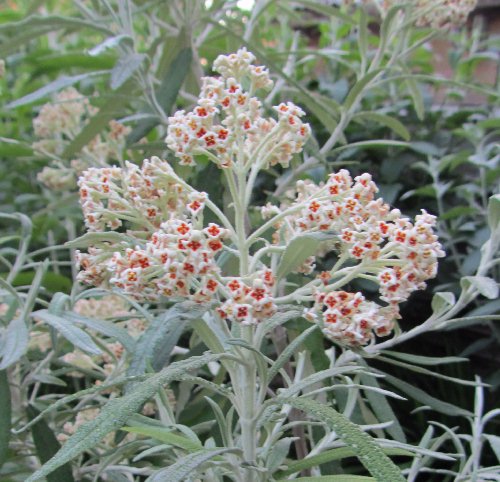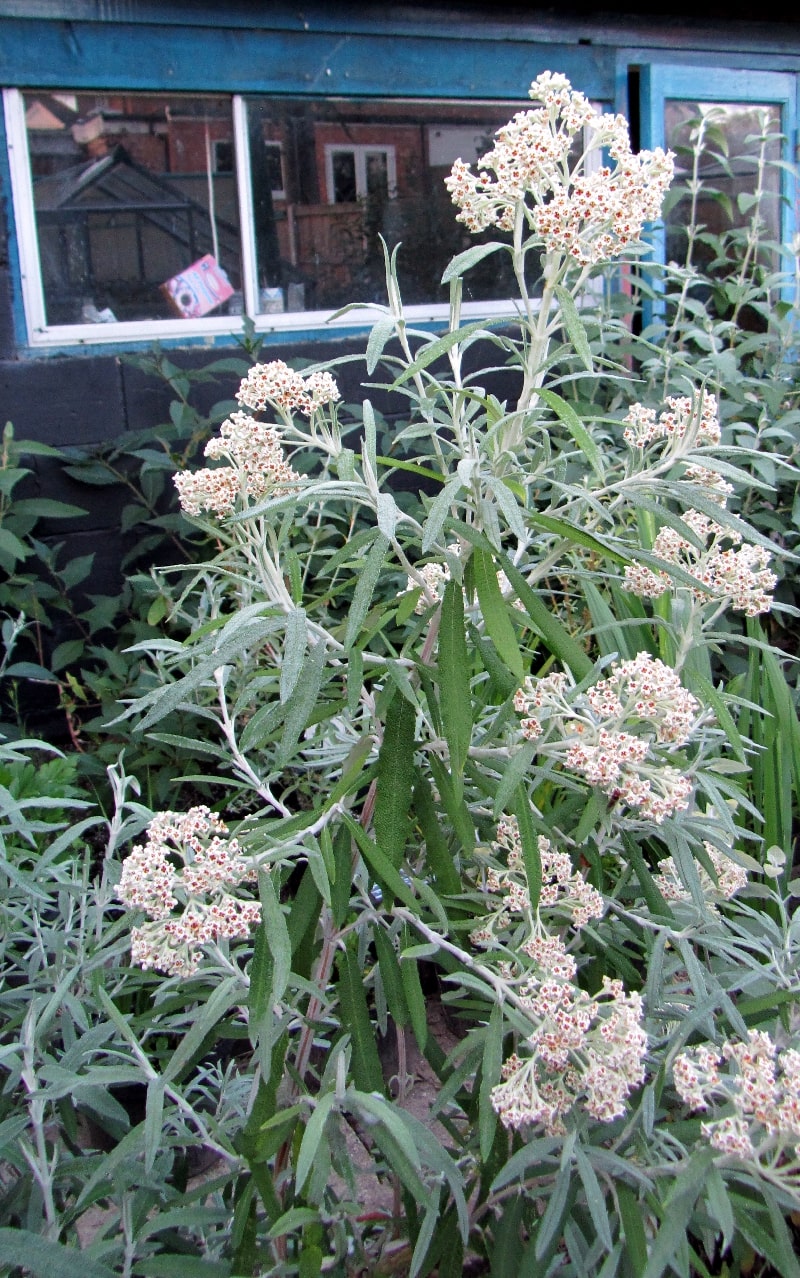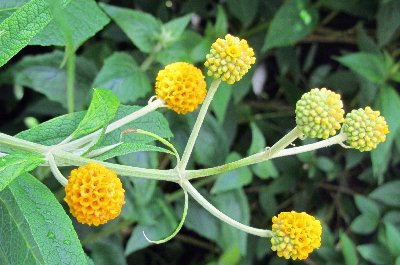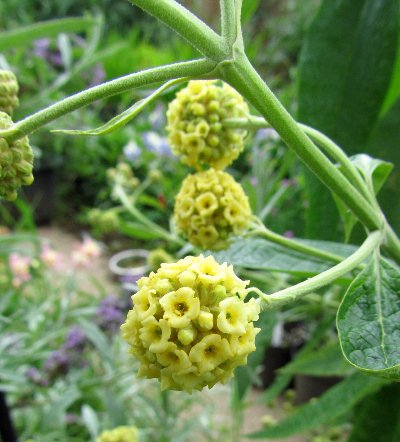
SPECIES BUDDLEJA
INTRODUCTION
These are the Buddleja (Buddleia) species I have some experience of growing. Some are fully hardy and some benefit from a little winter protection. They are from China and the Himalayas, Africa and South America. All African and Asian Buddlejas are hermaphrodite (male and female in the same flower), but many Buddlejas from the Americas are dioecious (separate male and female plants).
There is some confusion because the flowers appear to have both male (stamens) and female (pistil) parts but one or the other is non-functional. This is called cryptic dioecy and species that display this are described as being cryptically dioecious; in older texts it can be described as micro-dioecious.
I have found many Buddleja species currently being sold are misidentified and therefore mislabelled. Wherever possible, I have attempted to confirm, correct or comment on the labelling using the monograph of Leeuwenberg (1979).
See also:
A Comprehensive and Organised List of Buddleja Species
(with Wikipedia links)
Contents
AFRICA
● B. auriculata
● B. glomerata
● B. loricata
● B. salviifolia
● B. virgata
AMERICAS
● B. globosa and B. araucana
● B. speciosissima
ASIA
● B. albiflora
● B. alternifolia
● B. caryopteridifolia (spurious)
● B. colvilei
● B. crispa
● B. delavayi (syn. B. heliophila)
● B. fallowiana
● B. forrestii
● B. japonica
● B. lindleyana
● B. macrostachya
● B. myriantha
● B. nivea
● B. officinalis
AFRICA
Buddleja auriculata Benth.
A Buddleja from South Africa, B. auriculata is a large spreading shrub, which has glossy dark green leaves and abundant white flowers arranged in loose cymes or panicles. Although amongst the tiniest individual flowers of any Buddleja, the scent is both powerful and pleasant. Flowering time is late in the season, usually starting in September.
It is debatable whether this species is fully hardy, and it reacts badly to snow or hard frosts. However, if given some shelter and a free draining soil it should prove hardy in relatively mild regions. Even if it does die back, a mature plant should be able sprout again from the roots.
Buddleja glomerata H. L. Wendl.
From the semi-deserts of South Africa whereit is known as Karoo Sagewood. Buddleja glomerata has puckered silver foliage and is usually evergreen. It has the tiniest fluffy yellow flowers in large plumes with a perfume of reminiscent of cloves; it usually blooms around May under cover, but flowering is unreliable when grown in the open. Although it can tolerate cold, it is very unhappy in damp conditions.
Some consider it belongs in a separate genus, Chilianthus, along with Buddleja saligna (the False or Bastard Olive) and B. dysophylla, species in which the anthers protrude beyond the corolla tube on long filaments unlike in most other Buddleja. In contrast to B.saligna, the green stigmas of B. glomerata are also held proud of the corolla.
Sometimes it's sold as Buddleja 'Silver Service'.
Buddleja loricata Leeuwenb.
From South Africa and sometimes called Mountain Sagewood. It is a smallish shrub has rough strap-like leaves with a silvery underside. It is fully hardy, evergreen and doesn't even mind snow. It is grown mainly for its foliage but has interesting white flowers that come in June or early July. Pruning is optional but should probably be done straight after flowering; alternatively it can just be trimmed to be kept tidy.


Buddleja salviifolia (L.) Lam.
A variable species with a range across much of southern Africa, usually found growing at some altitude. The leaves are considered to look similar to sage and the plant is known as African Sagewood in South Africa. Blooms in late spring, April-May in the UK, and the flowers can be can be blue, lilac or white. Hardy and evergreen only in the southern UK, further north it may require a more sheltered spot.
The blue form is the most common in horticulture, selected for the fine flowers and attractive velvety foliage. The scent is second to none in the Buddleja family, and grown in a cool greenhouse, it'll fill the air with perfume.
This blue form is sometimes sold mis-identified as B.myriantha, which is an unmistakably different Asian Buddleja.
Buddleja salviifolia 'Alba' has unusual foliage somewhat different to the blue-form - the leaf-blade is a different shape and the upper surface is bullate. The white flowers, however, are identical in morphology to the blue cultivar and have a similar exquisite scent. They open in spring a little earlier than the blue-form.
The most common colour in the wild appears to be lilac, although this appears rare in cultivation. I've recently raised a few plants from South African seed, whose foliage more closely resembles the white-flowered plant, including lilac and pale violet forms. B. salviifolia is known to be a very variable species, and this divergence between the forms is no more dramatic than found in some other Buddleja species. There is a seperate page showing the different flower colours and a comparison of the foliage.
Buddleja virgata L.f.
Perhaps better known as Gomphostigma virgatum (L.f.) Baill., there have been recent moves to return this species to its original name of Buddleja virgata as used by Linnaeus the Younger. It comes from southern Africa and is associated with river banks and water courses, where it is known colloquially as Otterbush or River Star.
A small shrub with very narrow grey leaves, it grows to a metre and a half. The bright white flowers are arranged in spikes, but each one is larger (up to 15mm in diameter) compared the typical flower of the genus and is flat, without a significant corolla tube. The four-fold symmetry is typical for a Buddleja.
This species forms a robust and hardy plant that is tolerant of both wet conditions and drought. Flowering intermittently throughout the summer, it can be pruned hard in spring.
BACK TO CONTENTS
AMERICAS
Buddleja globosa Hope
A South American Buddleja from Chile and Argentina. It is a large shrub with glossy green leaves and intriguing golf-ball flowers about 15mm in diameter. It is probably the most popular garden Buddleja after B. davidii. Many cultivars are listed: 'Cally Orange'; Cannington Gold'; 'Lemon Ball'; to name three. There is little difference except for HCM98017 decribed below. There is also a variegated form with yellow spotted leaves. It is completely hardy in the UK and more or less evergreen in most of the UK. Flowers May to June and the bees love it.


B. globosa HCM98017 has very pale yellow flowers and smaller leaves.
B. araucana Phil., formerly called B.nappii Lorentz., is a closely related species with similar orange flowers but has brown down on stems and the underside of its narrower leaves. It is relatively uncommon in cultivation and it takes an expert to tell from B. globosa. In fact it has previously been known as B. globosa var. araucana (Phil.) Reiche, and not treated as a separate species at all.
Both B. araucana and B. globosa are cyptically dioecious (see above) like the majority of New World Buddlejas, although the flowers appear to be hermaphrodite. The plants that are in cultivation have not been sexed.
There is much more about these two species on a separate page HERE.
Buddleja speciosissima Taub.
Buddleja speciosissima is something very different indeed, a South American species with long, tubular orange-red flowers up to 2.5cm long, which emerge slowly from soft, furry buds. The attractive foliage is grey and felted. Unlike many species from the Americas, which are dioecious, B. speciosissima bears perfect (hermaphrodite) flowers and is self-fertile.
It comes from southern Brazil and has a very small range, restricted to Mount Itatiaia growing at an altiude of 2000-2500 metres. Despite the its tropical origins, it has evolved in harsh mountain conditions and proved hardy in southern UK gardens, where it forms a fairly low, scrubby shrub.
A closely related species with even longer flowers, B. longiflora, grows on the Serra Caparao in the same region.
BACK TO CONTENTS
ASIA
Buddleja albiflora Hemsley
Superficially, a species very like B. davidii, and quite closely related according to the latest DNA data. Despite the name, the flowers can be pale to medium lilac-pink. The leaves are large and pendulous, and the stems are usually round, rather than tetragonal (squared-off), often being pigmented and red/purple in colour. It is hardy, deciduous, and flowers slightly earlier (end of June onwards) than B. davidii, but can treated in the same way for pruning.
A newer introduction, BO 15-041 is from Chongqing, central China. This is a more vigorous example of the species, and has very long inflorescences made up of hundreds of tiny pinkish flowers.
Buddleja alternifolia Maxim.
Unlike virtually all Buddleja where the leaves are opposite, this one has alternate leaves. Sometimes called the Weeping Buddleja as it does resemble a willow. The arching stems of the previous years growth become covered in lilac flowers in late spring (May). These are in a spiral pattern all along the stem and not in a panicle or raceceme. It's deciduous so it is reduced to a bare skeleton in the winter but is really hardy, some claim even more hardy than B.davidii. Eventually it will grow into a small tree up to 4 metres across and 3 metres high, but can be pruned and shaped straight after flowering. Any later and it may not flower the next year.

Buddleja alternifolia 'Argentea'
Like the species but this cultivar has silvery-grey leaves (hence 'Argentea'). The flowers are a darker purple with reflexed petals and the scent is cleaner and stronger. It grows much slower than the species which is the only downside.

Buddleja aff. alternifolia 'Tsestangensis'
Buddleja tsestangensis Marquand, to give it the original name, is a white flowered form of B.alternifolia with grey, toothed leaves. It is also known under the name B. wardii KR4881 as some believe it may be a hybrid with B. crispa. It flowers slightly earlier than other Buddleja alternifolia and isn't fully deciduous in mild winters.

Buddleja caryopteridifolia
W. W. Sm.
(Spurious!)
Not the easiest name, but this looks a viable alternative to the finicky B.crispa. Fully hardy but deciduous, it has greyish foliage and purple flowers. The scent is a bit like B.crispa, so very pleasant. It flowers late spring (May) and can flower again in the late summer or autumn.
Up close the individual flowers resemble B. alternifolia 'Argentea' and occassionally branches have alternate leaves. The cultivar shown could be a B. alternifolia and B.crispa cross, possibly arising out of a natural hybridisation sometime in the past. I suspect it is in fact the hybrid B. x wardii, but it is currently being sold as B. caryopteridifolia.
The authentic B. caryopteridifolia has been described as a variety of B. crispa. There is more on this and other B. crispa varieties and hybrids HERE.
Buddleja colvilei
Hook.f. & Thomson
An unusual Himalayan Buddleja with the largeset flowers in the genus, each one about the size of a wiegela flower (about 1.5cm diameter) but with four petals. All types form a large shrub or small tree and have large leaves. B.colvilei gets hardier with age, but needs a sheltered spot to thrive. Young plants need extra protection over winter until they are fully established.
There are quite a few cultivars around now, mostly from wild-collected seeds, in shades of red and pink. An unnamed cultivar has pink flowers with a white throat. 'Tregye' has orange centres to the flowers and is particularly attractive.
Buddleja colvilei 'Kewensis'
The cultivar 'Kewensis', selected at Kew Gardens, is the most popular cultivar amongst the dozen or so available. It has dark red flowers and deeper green foliage - one of the finest Buddlejas you can grow and hardier than the pink form, but it still needs a sheltered spot. Cover with fleece in the winter to protect the buds from frost as it is spring flowering, anytime between April and June depending on conditions.
Buddleja crispa Benth.
Pretty pink flowers and soft grey foliage, the leaves are almost heart-shaped. This is an attractive Buddleja that can grow quite large and woody. It is fussy though and needs a very warm south-facing wall to survive. It also can't take any water-logging over winter and prefers dry conditions in summer to enhance the silvery foliage.
I have grown mine in a large pot so it can be kept under cover all winter, although it is still fully deciduous. Flowers in June-July and you can get a second flush in the autumn if you dead-head.
There is more on this and the other B. crispa forms (B. agasthosma; B. farreri; B. sterniana; B. tibetica; B. caryopteridifolia) and their hybrids on a dedicated page for the Buddleja crispa Complex.

Buddleja delavayi Gagnep.
Buddleja delavayi is a deciduous spring-flowerng species, which comes from south-western China. The flower buds are held dormant over winter on bare stems, and are both terminal and axiliary. The flowers are soft pink with a heady rose-like scent, and similar to other short-day Buddleja like B. officinalis and B.paniculata, but the leaves are much smaller than these other species. Some claim it can re-bloom in the autumn, although I've never managed to make that happen. Possibly root-hardy, but the flower-buds are easily frosted-off in all but the most sheltered situations. I grow in a large pot and drag it into the greenhouse for the winter.
The plant shown is usually sold as B. heliophila W. W. Sm., which is synonymous with B. delavayi.
Buddleja fallowiana
Balf.f. & W.W.Sm.
One of the species more closely related to B. davidii, B. fallowiana has felted grey leaves and white felted stems, too. The species can have white, lilac, lavender or pale blue flowers. Not as hardy as B. davidii, but should survive a moderate UK winter in a reasonably sheltered garden, though it will generally lose its leaves. Winter water-logging is lethal.
This fine pale blue cultivar is P&M 181, collected from a pine forest edge in Lijiang, north-west Yunnan at a altitude of 3170 metres. It appears to be quite hardy.
Buddleja fallowiana 'Alba'
The white, or alba, form is more commonly grown. This white form also tends to be hardier, though nowhere near as tough as B. davidii, and it usually still loses its leaves in winter.
Buddleja forrestii Diels
B. forrestii is a highly variable Himalayan species and is closely allied with B. macrostachya. The two species can be very similar and difficult to tell apart.
This plant is from Roseland House Garden and Nursery in Cornwall. So far it seems fairly hardy and kept its leaves over mild winters. A large and robust shrub, it flowers July and has off-white flowers with a mauve flush in the bud. Its seedlings I've grown make me think it's self-fertile.
There is more information on the B. forrestii & B. macrostachya page, including on the synonymous species Buddleja pterocaulis (also called B. longifolia Gagnep.) and Buddleja limitanea. There is also a key to help with the identification of each species.
Buddleja forrestii type limitanea
Often still called B. limitanea W. W. Sm., this is a smaller form of B. forrestii.
There is more information on the B. forrestii & B. macrostachya page.
Buddleja japonica Hemsley
B.japonica, as the name suggests, is native to Japan. The plant is hardy; although deciduous and tending to die back in winter, it grows again strongly from the base the following spring.
A member of the Curviflorae series (group) of Buddlejas (those with long, curved corolla tubes), which includes B.lindleyana and B.curviflora, it can be distinguished from other species by the lighter-green, toothed foliage and the winged-stems. In common with many of the Curviflorae Buddlejas, the flowers are purple, although the panicle is not one uniform shade, with individual flowers ranging from a deep colour to very pale.
Buddleja lindleyana Fortune
Summer flowering Chinese Buddleja with pretty purple tubular flowers in pendulous panicles but they have absolutely no scent. Glossy small green leaves on a shrub that can grow into a small tree eventually. This species also suckers so can spread out if not kept in check. Pruning, where necesssry, should be in spring. More or less hardy but a sheltered position is better, often grown against a wall. It can be evergreen or lose its leaves in a hard winter.
Improvements have been made on the species, with a number of smaller cultivars developed. One of the best is Peter Moore's "Little Treasure", a plant not much more than a metre high with small glossy leaves and more upright flower panicles.
Buddleja macrostachya
Wallich ex Benth.
A very variable species with a wide range across the Himalayan region and south-east Asia; the flowers can be anything from white through to wine-red; the flowering time can vary from mid-summer to Christmas. Until it flowers this species can be almost indistinguishable from B. forrestii. The plant shown left is PAB4198 from Shillong, (Meghalaya India) with pink flowers. This collection flowers very late in the season, about November, meaning a mild autumn is required for it to bloom properly. In my garden, it's forming a small tree and is over four metres in height.
There is more information, including other examples of this species and how to distinguish it from B. forrestii, on the B. forrestii & B. macrostachya page.
Buddleja myriantha Diels
Buddleja myriantha is also a very variable species, found in south-west China and northern Myanmar. The name is often misapplied in the horticultural trade to either to a form of B. curviflora or to the blue-flowered B.salviifolia. The authentic B.myriantha is related to both B.davidii and B.albiflora.
The plant with the purple flowers is H&M 1520 from Cangshan, Yunnan, China; the pink-lilac one is W/O 8047 from the same location, which more closely resembles B.albiflora. In both collections, the individual flowers are tiny; the species gains its name from the huge number of these diminutive flowers in each panicle.
B.myriantha can be distinguished from B.albiflora as follows: B.albiflora has rounded or subterete stems, whereas B.myriantha has noticeably four-angled stems; the calyx and exterior of the corolla tube are smooth in B.albiflora, but in B.myriantha the calyx and outside of the corolla tube are distinctly tomentose (hairy), as can be seen in the close-up of W/O 8047.
The seedlings of W/O8047 were tricky to grow, as they start out very leggy and then scramble along the soil re-rooting in several places. They only became shrubby once fully mature
See also the Illustration from Flora of China for a comparison.
Another example of B. myriantha, also from collection W/O 8047. This one has flowers of a much more blue-violet shade and the eyes are lacking in the usual yellow pigment. A feature common in B. myriantha is the ridged rhachis (the stem of the inflorescence) seen in this photo, which is very different from the smooth, more-rounded stems of B. albiflora.
Buddleja nivea Duthie
From China again, this one is distinguished by its heavily felted leaves and stems. The inflorescences are in long cats' tail panicles but the individual purple flowers are unremarkable. It is mostly grown for its large felted foliage. Fully deciduous but quite hardy and it should be pruned hard in spring to keep it a small shrub.


Buddleja nivea type stenostachya
Another form of B. nivea, this used to be considered a separate species (Buddleja stenostachya Rehder & E. H. Wilson), and is still sold as such. The leaves have smooth edges and the stem indumentum is less floccose, but otherwise the shrub is very similar to the species type. The inflorescences are a little different though, and it has very narrow panicles, for which it is named (stenostachya means narrow flower spikes). The individual flowers themselves are very similar to the species - purple, hairy throated and with a very short corolla tube. Possibly not as hardy as the other forms of B. nivea.
Buddleja nivea var. yunnanensis
Rehder & Wilson
Not to be confused with B. yunnanensis Gagnep., a distinct and much smaller Asian species. Very like the species type in many ways, although it will grow much bigger. The leaves are longer, heavily felted and more conspicuously serrated. The purple flowers are not particularly remarkable and individually very much the same as the other types. Unlike others which flower sequentially up the panicle, the flowers open fairly randomly. Deciduous, vigorous and hardy.
There is the possibility that the Yunnan form of B. nivea has undergone a doubling of its chromosome number, from hexa- to dodecaploid (Moore 1960), and this could account for the size and vigour.
Ref: Moore R. 1960. Cytotaxonomic notes on Buddleja. American Journal of Botany 47: 511-517.

Buddleja officinalis Gagnep.
Unusually, this is a winter-flowering large shrub. Soft lilac-pink flowers open when the plant has few leaves. In summer it has large, long, soft and felted leaves, the stems also have brown felt so it is mostly grown as an attractive foliage plant. It loses most of its leaves for the winter. Mine flowered February, although this species can be in flower at Christmas provided it is in a particularly warm sunny position or kept under cover. Just hardy enough to grow in a sheltered spot, although the flower buds would be damaged by hard frost.
Buddleja officinalis is very similar to B. paniculata Wallich; the latter tends to have shorter leaves, which may be toothed.

Email:
buddlejagarden@gmail.com
© The Buddleja Garden 2011-2025.


































